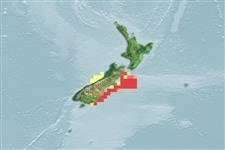Lớp phụ Cá sụn (cá mập và cá đuối) (sharks and rays) >
Torpediniformes (Electric rays) >
Narkidae (Sleeper rays)
Etymology: Typhlonarke: Greek, typhlops = blind + Greek, narke = numbness (Ref. 45335).
Environment: milieu / climate zone / depth range / distribution range
Sinh thái học
Biển Tầng đáy biển sâu; Mức độ sâu 65 - 900 m (Ref. 26346), usually 300 - 400 m (Ref. 114953). Deep-water; 42°S - 47°S, 169°E - 176°E (Ref. 114953)
Southwest Pacific: endemic to New Zealand.
Bộ gần gũi / Khối lượng (Trọng lượng) / Age
Maturity: Lm ? range ? - ? cm
Max length : 45.0 cm TL con đực/không giới tính; (Ref. 114953)
Short description
Khóa để định loại | Hình thái học | Sinh trắc học
Tia cứng vây hậu môn: 0. Dark brown dorsally, light brown ventrally (Ref. 26346).
Found on the continental shelf and slope (Ref. 26346). Produces up to 11 pups a litter. Males reaches maturity at 35-40 cm TL; birth size at 9-10 cm TL (Ref. 114953).
Life cycle and mating behavior
Maturities | Sự tái sinh sản | Spawnings | Egg(s) | Fecundities | Ấu trùng
Presumably ovoviviparous, with up to 11 young born at 9-10 cm (Ref. 26346).
Cox, G. and M. Francis, 1997. Sharks and rays of New Zealand. Canterbury Univ. Press, Univ. of Canterbury. 68 p. (Ref. 26346)
IUCN Red List Status (Ref. 130435)
Threat to humans
Harmless
Human uses
Các công cụ
Special reports
Download XML
Các nguồn internet
Estimates based on models
Phylogenetic diversity index (Ref.
82804): PD
50 = 0.7502 [Uniqueness, from 0.5 = low to 2.0 = high].
Bayesian length-weight: a=0.01000 (0.00244 - 0.04107), b=3.04 (2.81 - 3.27), in cm total length, based on all LWR estimates for this body shape (Ref.
93245).
Mức dinh dưỡng (Ref.
69278): 3.3 ±0.3 se; based on size and trophs of closest relatives
Thích nghi nhanh (Ref.
120179): thấp, thời gian nhân đôi của chủng quần tối thiểu là 4.5 - 14 năm (Assuming fecundity<100).
Fishing Vulnerability (Ref.
59153): Low to moderate vulnerability (35 of 100).
